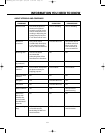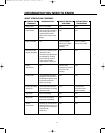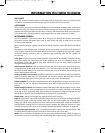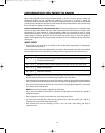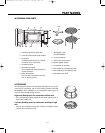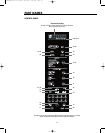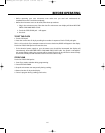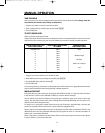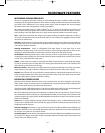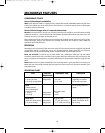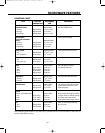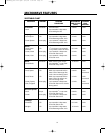
18
MICROWAVE FEATURES
MICROWAVE COOKING PRINCIPLES
The key to successful microwave cooking is understanding the basic conditions which may affect
cooking results.The speed and evenness of microwave cooking are influenced by characteristics of the
food itself and by differences in line voltage. House power varies throughout the country. Voltage
fluctuates and is lower during periods of peak consumption.
Microwaves penetrate foods to a depth of about
3
/4 to 1
1
/2 inches on all surfaces: top, bottom and
sides.The interior of foods greater than 2 inches in diameter heats by conduction,as it does in conven-
tional cooking.Foods with high water,fat or sugar content respond quickly to microwave energy.
Size - Small pieces cook faster than large ones.To speed cooking, cut pieces smaller than 2 inches so
microwave can penetrate to the center from all sides.For even cooking,cut vegetables,fruit and meat
into pieces of uniform size.
Quantity - Small amounts cook faster than large ones.Microwaving time is always directly related to
the amount of food and increases with the quantity.When doubling a recipe,increase time by about
one-half and check for doneness.
Starting temperature - Frozen or refrigerated food takes longer to heat than food at room
temperature. Cooking times in this book are based on normal storage temperatures. Since rooms,
refrigerators and freezers differ in temperature,check for doneness at the minimum time.
Fat and bone - Marbling within meat or a thin,even layer of fat on a roast attracts energy and speeds
cooking.Drain excess drippings in dish during cooking to speed cooking.Bone conducts heat,so areas
next to it may cook faster than other areas.
Shape - Foods which are irregular in shape, like fish fillets, chicken breasts or drumsticks, take longer
to cook in the thicker parts. To help them cook evenly, place the thickest parts to the outside of the
dish,where they will receive more energy.
Moisture content - Microwaves are readily attracted to moisture. Naturally moist foods microwave
better than dry ones.Add a minimum of liquid to moist foods,as excess water slows cooking.
Density.Porous foods,such as ground beef or mashed potatoes,cook faster than dense foods,such as
steak or whole potatoes, since microwaves penetrate them more easily.Turn dense foods over after
one-half cooking time to speed and equalize cooking.
DEFROSTING FROZEN FOODS
Defrosting food with the microwave oven is not only faster than any other method, it can also give
better results. Many microwave ovens are designed with a special automatic defrost setting which
makes it safe,quick and easy to defrost meat and poultry.
Once frozen meat is defrosted,it begins to lose its juices.Microwave ovens give you the advantaged of
letting you defrost meat just before you cook it for maximum juiciness and quality.
Microwave defrosting is easy,but some attention is needed to make sure that the ice crystals in frozen
food melt without the food starting to cook.MEDIUM-LOW (30%) is fast enough to be convenient but
gradual enough to give good results.At MEDIUM (50%) meat defrosts in about one-third less time but
needs more attention.
Place plastic or paper-wrapped package of frozen food directly in oven.To speed defrosting, remove
wrap as soon as possible and cover food with wax paper to hold in heat and prevent moisture loss.Foil
wrappings must be removed.
Remove wrapping from turkey so you can feel warm spots as it defrosts. Metal clamps holding legs
should be removed as soon as possible.Start breast side down,shield warm areas with small strips of
foil and turn over after each one-fourth of time.
Let turkey stand 20 to 30 minutes submerged in cold water after defrosting,until giblets and neck can
be removed and breast meat under wings is completely defrosted.Turkey may be microwaved with
clamps if they are difficult to move.
1.CMO24SS_DCS 374 E.qxd 4/21/04 9:42 AM Page 18



